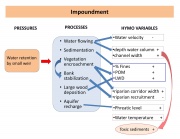Impoundment
Contents
Impoundment
04. Morphological alterations
General description
Any transverse barrier to the flow in a river impounds water upstream. When this barrier is small (e.g. less than 10 m high) it may be called a weir, dike or small dam. Barriers that are taller than 15 m are all termed dams. All of these barriers are used for retaining water for many purposes and the river is transformed into an impoundment upstream. Natural flow velocity is reduced due to the presence of the impoundment, resulting in the deposition of transported sediments. The effectiveness of a reservoir as a sediment trap is mainly dependent upon its storage capacity and the length of time that it stores water (Brune, 1953[1]), but even the smallest reservoirs are likely to trap most sand sized and finer particles, and large reservoirs are likely to trap close to 100% of transported mineral sediment particles.
Effect/Impact on (including literature citations)
This type of pressure changes the hydraulic conditions on the impounded river reach, from lotic to lentic. A transverse obstacle such as a weir increases water depth and reduces water velocity, and as a result fine sediment is deposited, clogging interstitial habitats. However, when high flows occur, these fine sediments can be mobilised and washed out over these relatively small structures. Small impoundments flood areas that were previously part of the channel margin and floodplain. Such flooding can have physical and chemical effects both within the impoundment and downstream. For example, in relatively dry environments, more frequent inundation can exaccerbate salinization, as was observed in association with flooding of once-temporary wetlands in Australia (Walker & Toms 1993). Increased inundation can benefit native fishes, as was observed in southwestern streams of the USA, by disproportionately displacing non-native fishes (Schultz et al. 2003). Moreover, the beneficial effects of impoundments for certain species can have indirect effects on HYMO processes such as suspended load chemical composition. Barton et al. (2000) found significantly higher concentrations of suspended inorganic matter in the outflows than the inflows of three impoundments along an urban stream in southern Ontario during baseflow conditions, due to carp (Cyprinus carpio) feeding activities. The impact of small impoundments can also be assessed by observing the impact of their removal and the restoration of natural flow dynamics. Stanley et al. (2002) observed a significant decrease in the width of the active channel within the impoundment (from 59 m 2 to 11 m 2 ) as a result of the removal of a low-head dam at Baraboo River, Wisconsin. There was an increase in the extent of ‘loose’ bed sediments including an increase in the sand fraction immediately following dam removal, but the channel adjusted rapidly to an equilibrium form, particularly following the occurrence of the first significant flood. Overall, only small and transient geomorphological and ecological changes and no alteration of channel dimensions were observed in downstream reaches. Within one year of removal, there were no significant differences in macroinvertebrate assemblages among the formerly impounded reaches, an upstream reference site, or reaches downstream of the dam site. The small changes and rapid recovery reflect the relatively large channel size and the small volume of stored sediment associated with this relatively small impoundment.
Case studies where this pressure is present
- Fovant_-_Demonstrating_strategic_restoration_and_management_STREAM_(LIFE05_NAT/UK/000143)
- Klebach_-_Side_channel
- Popina
- Bakenhof_-_Dyke_relocation
- Bouxweerd
- River_Wensum_Rehabilitation_Project
- Asseltse_Plassen_-_Bank_erosion
- Rijkelse_Beemden_-_River_bed_widening
- Babina
- Chilhampton_-_Demonstrating_strategic_restoration_and_management_STREAM_(LIFE05_NAT/UK/000143)
- Buiten_Ooij_-_Sluice_operation_
- Narew_river_restoration_project_
- Lower_Traun
- Middle_Warta_River_Valley
- Heltondale_Beck_Flow_restoration
- Drava_-_Kleblach
- KUIVAJOKI
- Emån_-_Emsfors
Possible restoration, rehabilitation and mitigation measures
- Reduce undesired sediment input
- Improve continuity of sediment transport
- Manage dams for sediment flow
- Ensure minimum flows
- Establish environmental flows / naturalise flow regimes
- Increase flood frequency and duration in riparian zones or floodplains
- Shorten the length of impounded reaches
- Remove barrier
- Manage sluice and weir operation for fish migration
- Remove sediments
- Retain floodwater
- Improve backwaters
- Isolation of water bodies
Useful references
Brune, G.M., 1953. Trap efficiency of Reservoirs. Transactions American Geophysical Union 34: 407–419.
Other relevant information
Cite error: <ref> tags exist, but no <references/> tag was found
